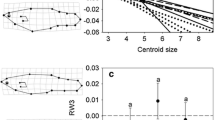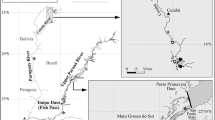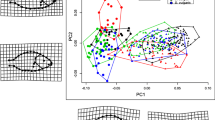Synopsis
The ecological classification of fishes into reproductive guilds is based on the premises that (1) reproductive styles and early ontogeny are closely related, and (2) both are correlated with the ecology of a species. A comparison of early ontogenies of logperch (Percina caprodes), rainbow darter (Etheostoma caeruleum), and fantail darter (E. flabellare) confirmed these premises, and provided possible explanations for diversity within the Etheostomatini. Young logperch have limited vitelline circulation, hatch while still poorly developed, and therefore must drift from oxygen rich lotic habitats to lentic habitats where small planktonic prey are available. Young rainbow and fantail darters have extensive vitelline plexuses, are well developed at transition to first feeding, and begin feeding on aquatic insects. Thus there is no necessity for a drift interval. As a result, the latter species are adapted for stream life. Interspecific differences in reproductive styles and early ontogenies may have contributed to speciation of darters by allowing partitioning of breeding sites and food resources for young. In addition, reduced drift dispersal and small stream habitation may have indirectly contributed to speciation by reducing genetic exchange among populations.
Similar content being viewed by others
References cited
Balesic, H. 1971. Comparative ecology of four species of darters (Etheostomatinae) in Lake Dauphin and its tributary, the Valley River. M.Sc. Thesis, Univ. Manitoba, Winnepig. 77 pp.
Balon, E.K. 1975a. Reproductive guilds of fishes: a proposal and definition. J. Fish. Res. Board Can. 32: 821–864.
Balon, E.K. 1975b. Terminology of intervals in fish development. J. Fish. Res. Board Can. 32: 1663–1670.
Balon, E.K. 1981a. Additions and amendments to the classification of reproductive styles in fishes. Env. Biol. Fish. 6: 377–389.
Balon, E. K. 1981b. Saltatory processes and altricial to precocial forms in the ontogeny of fishes. Amer. Zool. 21: 573–596.
Balon, E.K. 1984. Patterns in the evolution of reproductive styles in fishes. pp. 35–53. In: C.W. Potts & R.J. Wootton (ed.) Fish Reproduction: Strategies and Tactics, Academic Press London.
Barlow, G.W. 1981. Patterns of parental investment, dispersal and size among coral-reef fishes. Env. Biol. Fish. 6: 65–85.
Belyy, N.D. 1972. Downstream migration of the pike-perch Lucioperca lucioperca (L.) and its food in the early development stages in the lower reaches of the Dnieper. J. Ichthyol. 12: 465–472.
Constanz, G.D. 1979. Social dynamics and parental care in the tessellated darter (Pisces: Percidae). Proc. Acad. Nat. Sci. Phila. 131: 131–138.
Cooper, J.E. 1978. Eggs and larvae of the logperch, Percina caprodes (Rafinesque). Amer. Midl. Nat. 99: 257–269.
Cooper, J.E. 1979. Description of eggs and larvae of fantail (Etheostoma flabellare) and rainbow (E. caeruleum) darters from Lake Erie tributaries. Trans. Amer. Fish. Soc. 108: 46–56.
Dingerkus. G. & L.D. Uhler. 1977. Enzyme clearing of alcian blue stained whole small vertebrates for demonstration of cartilage. Stain Technol. 52: 229–232.
Ginsburg, A. S. 1963. Sperm-egg association and its relationship to the activation of the egg in salmonid fishes. J. Embryol. Exp. Morphol. 11: 13–33.
Grassle, J.F. & J.P. Grassle. 1978. Life histories and genetic variation in marine invertebrates. pp. 347–364. In: B. Battaglia & J.A. Beardmore (ed.) Marine Organisms, Plenum Press, New York.
Hansen, T.A. 1978. Larval dispersal and species longevity in Lower Tertiary gastropods. Science 199: 885–887.
Hodson, P.V. & J.B. Sprague. 1975 Temperature-induced changes in acute toxicity of zinc to Atlantic salmon (0Salmo salar). J. Fish. Res. Board Can. 32: 1–10.
Hubbs, C. & K. Strawn. 1957. Survival of F1 hybrids between fishes of the subfamily Etheostomatinae. J. Exp. Zool. 134: 33–62.
Hubbs, C.L. & K.F. Lagler. 1958. Fishes of the Great Lakes Region. Rev. ed. Cranbrook Inst. Sci. Bull. No. 26. 213 pp.
Hynes, H.B.N. 1970. The ecology of running waters. Univ. Toronto Press, Toronto. 555 pp.
Kryzhanovsky, S.G. 1949. Eco-morphological principles of develoment among carps, loaches and catfishes. Tr. Inst. Morph. Zhiv. Severtsova 1: 5–332. (In Russian).
(Part 2, Ecological groups of fishes and patterns of their distribution, pp. 237–331, Transl. from Russian by Fish. Res. Board Can. Transl. Set. No. 2945, 1974).
Lake, C.T. 1936. The life history of the fan-tailed darter Catonotus flabellaris flabellaris (Rafinesque). Amer. Midl. Nat. 17: 816–830.
Lee, D.S., C.R. Gilbert, C.H. Hocutt, R.E. Jenkins, D.E. McAllister & J.R. Stauffer Jr, 1980. Atlas of North American freshwater fishes. N.C. State Mus. Nat. Hist., Raleigh. 867 pp.
Mahon, R. 1981. Patterns in the fish taxocenes of small streams in Poland and Ontario. Ph.D. Thesis, University of Guelph, Guelph. 297 pp.
McElman, J.R. & E.K. Balon. 1979. Early ontogeny of walleye Stizostedion vitreum, with steps of saltatory development. Env. Biol. Fish. 4: 309–348.
Meats, A. 1971. The relative importance to population increase of fluctuations in mortality, fecundity and the time variables of the reproductive schedule. Oecologia 6: 223–237.
Page, L.M. 1974. The life history of the spottail darter, Etheostoma squamiceps, in Big Creek, Illinois, and Ferguson Creek, Kentucky. III. Nat. Hist. Surv. Biol. Notes 89: 1–20.
Paine, M.D. 1979. Feeding relationships of four species of darters (Etheostoma) in Irvine Creek, Ontario. M.Sc. Thesis, University of Waterloo, Waterloo. 163 pp.
Paine, M.D., J.J. Dodson & G. Power. 1982. Habitat and food resource partitioning among four species of darters (Percidae: Etheostoma) in a southern Ontario stream. Can. J. Zool. 60: 1635–1641.
Petravicz, W.P. 1938. The breeding habits of the black-sided darter, Hadropterus maculatus Girard. Copeia 1938: 40–44.
Rosenblatt, R.H. 1963. Some aspects of speciation in marine shore fishes. Syst. Assoc. Publ. 5: 171–180.
Scheltema, R.S. 1971. Larval dispersal as a means of genetic exchange between geographically separated populations of shallow-water benthic marine gastropods. Biol. Bull. 140: 284–322.
Scheltema, R.S. 1978. On the relationship between dispersal of pelagic veliger larvae and the evolution of marine proso-branch gastropods. pp. 303–322. In: B. Battaglia & J.A. Beardmore (ed.) Marine Organisms, Plenum Press, New York.
Scott, W.B. & E.J. Crossman. 1973. Freshwater fishes of Canada. Fish. Res. Board Can. Bull. 183. 966 pp.
Starnes, W.C. 1977. Ecology and life history of the endangered snail darter, Percina tanasi Etnier. Tenn. Wildlife Resources Agency Tech. Rept.: 77–52.
Strathmann, R.R. 1978. The evolution and loss of feeding larval stages of marine invertebrates. Evolution 32: 894–906.
Strawn, K. & C. Hubbs. 1956. Observations on stripping small fishes for experimental purposes. Copeia 1956: 114–116.
Turner, C.L. 1921. Food of the common Ohio darters. Ohio J. Sci. 22: 41–62.
Vrba, E.S. 1980. Evolution, species and fossils: how does life evolve? S. Afr. J. Sci. 76: 61–84.
Winn, H.E. 1958a. Observations on the reproductive habits of darters (Pisces-Percidae). Amer. Midl. Nat. 59: 190–212.
Winn, H.E. 1958b. Comparative reproductive behavior and ecology of fourteen species of darters (Pisces-Percidae). Ecol. Monog. 28: 155–191.
Author information
Authors and Affiliations
Rights and permissions
About this article
Cite this article
Paine, M.D. Ecological and evolutionary consequences of early ontogenies of darters (Etheostomatini). Environ Biol Fish 11, 97–106 (1984). https://doi.org/10.1007/BF00002258
Received:
Accepted:
Issue Date:
DOI: https://doi.org/10.1007/BF00002258




